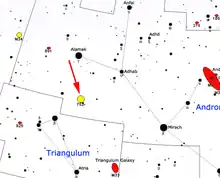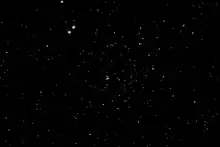| NGC 752 | |
|---|---|
 NGC 752 | |
| Observation data (J2000 epoch) | |
| Right ascension | 01h 57m 41s[1] |
| Declination | +37° 47.1′[1] |
| Distance | 1,470 ly[2] (450 pc) |
| Apparent magnitude (V) | 5.7[3] |
| Apparent dimensions (V) | 75′ |
| Physical characteristics | |
| Other designations | Caldwell 28, Cr 23 |
| Associations | |
| Constellation | Andromeda |

NGC 752 (also known as Caldwell 28) is an open cluster in the constellation Andromeda. The cluster was discovered by Caroline Herschel in 1783 and cataloged by her brother William Herschel in 1786, although an object that may have been NGC 752 was described by Giovanni Batista Hodierna before 1654.[4]
The large cluster lies 1,400 light-years away from the Earth and is easily seen through binoculars, although it may approach naked eye visibility under good observing conditions. A telescope reveals about 60 stars no brighter than 9th magnitude within NGC 752.[3][5]
Components
The most up-to-date research lists 302 stars as members of NGC 752.[2] Since the age of the cluster is 1.34±0.06 Gyr, they are mainly low mass stars on the main sequence or red giants, with a main sequence turnoff at about F0. A blue straggler star is also present, along with some spectroscopic binaries and variable stars.[6][7] The detached eclipsing binary DS Andromedae is a member of this cluster.[8]
Images

Notable stars
| Name | Right ascension | Declination | Apparent magnitude (V) | Spectral type | Database references | Relevance |
|---|---|---|---|---|---|---|
| TYC 2816-327-1 | 01h 56m 08.9572s | +37° 39' 52.7528" | 10.41 | F5.3V[6] | Simbad | Gamma Doradus variable |
| DS Andromedae | 01h 57m 46.0561s | +38° 04' 28.43112" | 10.44 - 10.93 (variable) | F3IV-V + G0V (double) | Simbad | Beta Lyrae variable |
| BD+37 416 | 01h 56m 10.3002s | +37° 45' 00.0301" | 10.00 | F2III | Simbad | Spectroscopic binary |
| BD+37 416B | 01h 56m 11.1020s | +37° 45' 11.3889" | 11.19 | F0 | Simbad | Candidate companion of BD+37 416 |
| TYC 2816-1390-1 | 01h 56m 12.8772s | +38° 01' 43.1869" | 10.88 | F3V | Simbad | Spectroscopic binary |
| TYC 2319-568-1 | 01h 56m 57.5899s | +37° 23' 20.6538" | 10.6 | F2V | Simbad | Spectroscopic binary |
| 2MASS J01571216+3756048 | 01h 57m 12.1584s | +37° 56' 04.7909" | 11.9 | G5.0V[6] | Simbad | Spectroscopic binary |
| BD+36 364 | 01h 57m 25.9968s | +37° 43' 19.6966" | 10.4 | F2III | Simbad | Spectroscopic binary |
| QX Andromedae | 01h 57m 57.7818s | +37° 48' 22.4500" | 11.28 - 11.50 (variable) | F5 | Simbad | W Ursae Majoris variable |
| 2MASS J01575883+3741269 | 01h 57m 58.8386s | +37° 41' 26.9575" | 12.31 | F8 | Simbad | Spectroscopic binary |
| TYC 2816-691-1 | 01h 58m 16.8604s | +37° 38' 15.9955" | 11.21 | F5V | Simbad | Spectroscopic binary |
| V447 Andromedae | 01h 58m 53.9322s | +37° 34' 42.5263" | 13.39 | K3.0[6] | Simbad | RS Canum Venaticorum variable |
| BD+36 348 | 01h 55m 27.6831s | +37° 34' 04.6482" | 10.14 | F2V | Simbad | Spectroscopic binary |
| BD+37 410 | 01h 55m 29.2926s | +37° 50' 26.3171" | 9.94 | F4III | Simbad | Eclipsing binary[8] |
| BD+37 418 | 01h 56m 18.8954s | +37° 58' 00.4602" | 8.97 | G9III | Simbad | Spectroscopic binary |
| HD 11812 | 01h 56m 49.7623s | +38° 01' 21.6883" | 9.13 | F3V | Simbad | In the HD catalogue |
| HD 11811 | 01h 56m 50.4330s | +38° 01' 58.1400" | 8.91 | G2V | Simbad | Spectroscopic binary |
| BD+37 431 | 01h 57m 36.2116s | +37° 45' 10.1549" | 9.85 | F2III | Simbad | Spectroscopic binary |
| BD+36 367 | 01h 57m 37.3494s | +37° 29' 27.6181" | 9.75 | A0III | Simbad | Blue straggler[7] |
| BD+36 368 | 01h 57m 37.5965s | +37° 39' 37.9032" | 8.85 | K1III | Simbad | Spectroscopic binary |
| BD+37 439 | 01h 57m 59.3462s | +37° 54' 53.9679" | 9.85 | F2III | Simbad | Spectroscopic binary |
| BD+37 444 | 01h 58m 36.8870s | +37° 45' 10.7241" | 9.62 | F2V | Simbad | Spectroscopic binary |
| TYC 2816-771-1 | 01h 58m 40.0620s | +37° 38' 05.2030" | 12.43 | F2V | Simbad | Spectroscopic binary |
| 2MASS J01591990+3723230 | 01h 59m 19.8967s | +37° 23' 23.0364" | 12.893 | – | Simbad | Spectroscopic binary |
References
- 1 2 "NGC 752". SIMBAD. Centre de données astronomiques de Strasbourg. Retrieved 10 February 2018.
- 1 2 Gaysin, Renat; Hojaev, Alisher (2022). Open cluster NGC752: Revision by GAIA EDR3 data. Cambridge Workshop on Cool Stars. p. 82. Bibcode:2022csss.confE..82G. doi:10.5281/zenodo.7481659.
- 1 2 Dunlop, Storm (2005). Atlas of the Night Sky. Collins. ISBN 978-0-00-717223-8.
- ↑ Seligman, Courtney. "New General Catalogue objects: NGC 750 - 759". cseligman.com. Retrieved 10 February 2018.
- ↑ Frommert, Kronberg, SEDS: NGC 752
- 1 2 3 4 Agüeros, M. A.; Bowsher, E. C.; Bochanski, J. J.; Cargile, P. A.; Covey, K. R.; Douglas, S. T.; Kraus, A.; Kundert, A.; Law, N. M.; Ahmadi, A.; Arce, H. G. (July 2018). "A New Look at an Old Cluster: The Membership, Rotation, and Magnetic Activity of Low-mass Stars in the 1.3 Gyr Old Open Cluster NGC 752". The Astrophysical Journal. 862 (1): 33. arXiv:1804.02016. Bibcode:2018ApJ...862...33A. doi:10.3847/1538-4357/aac6ed. S2CID 119438236.
- 1 2 Belloni, T.; Verbunt, F. (January 1996). "Soft X-rays from the intermediate-age open cluster NGC 752". Astronomy and Astrophysics. 305: 806. Bibcode:1996A&A...305..806B.
- 1 2 Sandquist, Eric L.; Buckner, Andrew J.; Shetrone, Matthew D.; Barden, Samuel C.; Pilachowski, Catherine A.; Deliyannis, Constantine P.; Harmer, Dianne; Mathieu, Robert; Meibom, Søren; Frandsen, Søren; Orosz, Jerome A. (2023). "Evolved Eclipsing Binaries and the Age of the Open Cluster NGC 752". The Astronomical Journal. 165 (1): 6. arXiv:2210.11649. Bibcode:2023AJ....165....6S. doi:10.3847/1538-3881/ac9c59. S2CID 253080539.
External links
- SEDS – NGC 752
- perseus.gr – NGC 752 in a hires LRGB CCD image
- NGC 752 on WikiSky: DSS2, SDSS, GALEX, IRAS, Hydrogen α, X-Ray, Astrophoto, Sky Map, Articles and images